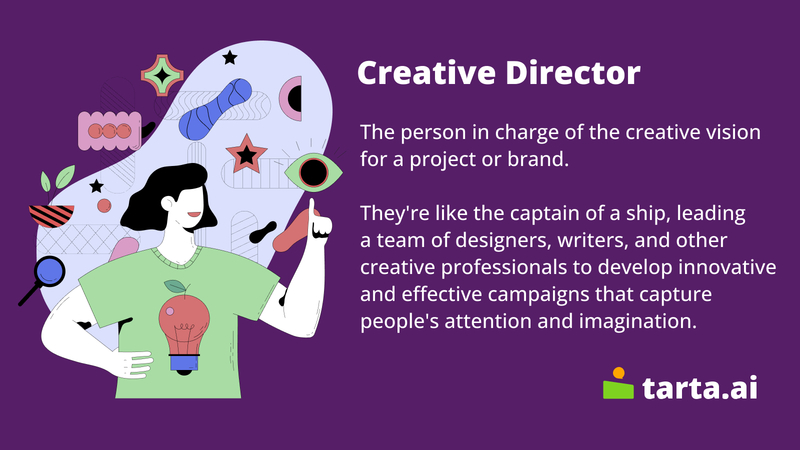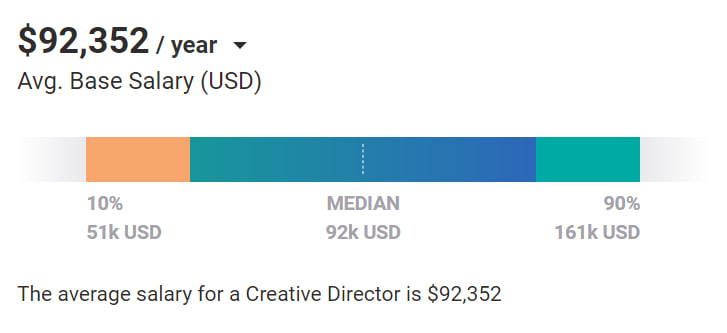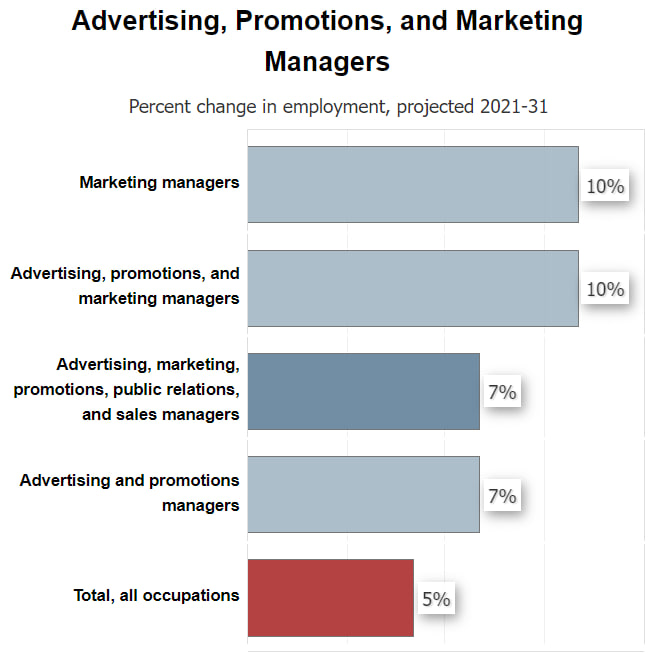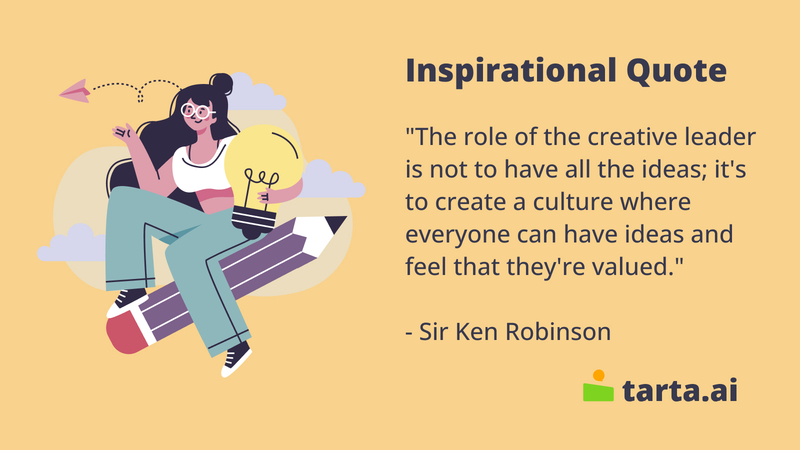Mastering the Art of Creative Direction: A Guide to Success

The role of a creative director is essential for developing and communicating the creative vision and strategy for a brand or company. This position requires a combination of technical and soft skills, including leadership, communication, creativity, and problem-solving. In this article, we will discuss the responsibilities of a creative director, the necessary skills, how to develop a career in this field, and the job environment. We will also cover the pros and cons of the job, alternative career options, and government programs that can provide support for creative directors. Whether you're starting your career or looking to advance in the field, this article provides valuable insights for anyone interested in pursuing a career as a creative director.
1. Job Description
A creative director is a professional who oversees the creative aspects of a project or organization. They are responsible for developing and executing the creative vision of a brand, product, or campaign.

Creative directors can work in various industries, such as advertising, marketing, fashion, film, video games, and more. They lead a team of designers, artists, writers, and other creatives, providing direction and feedback to ensure that the work meets the project's objectives and aligns with the brand's identity.
Creative directors typically have a background in design, art, or advertising, and often have years of experience working in the industry. They need to have excellent communication and leadership skills, as well as a deep understanding of the creative process and the market trends.
Requirements
The requirements for a creative director may vary depending on the industry, company, and specific role, but generally, the following qualifications and skills are commonly sought after:
Requirement | Description |
Education and experience | A bachelor's degree in a related field such as graphic design, art, marketing, or advertising is typically required. Additionally, several years of experience in a creative role, such as a graphic designer, copywriter, or art director, is necessary. |
Creative skills | Creative directors must have strong creative skills, including conceptual thinking, artistic ability, and design expertise. They should have a deep understanding of typography, color, composition, and layout. |
Leadership and management | A creative director must be an effective leader who can manage and inspire a team of creatives. They must have excellent communication and interpersonal skills and be able to provide clear direction and feedback to their team. |
Strategic thinking | A creative director should be able to think strategically and understand how creative work contributes to the overall goals of the company. They must be able to balance creative vision with business objectives. |
Industry knowledge | A creative director should have a deep understanding of the industry they work in and stay up-to-date on industry trends, technologies, and best practices. |
Problem-solving skills | Creative directors should be able to think critically and solve problems creatively, finding solutions that meet the project's objectives while remaining within the scope, budget, and timeline. |
Portfolio | A strong portfolio that demonstrates their creative skills, experience, and expertise is essential for any creative director. It should showcase a range of work and highlight their ability to create effective and impactful campaigns. |
Duties and Responsibilities
The main responsibilities of a creative director can vary depending on the industry, company, and specific role, but generally, they are responsible for the following:
- Developing creative vision and strategy: Developing and communicating the creative vision and strategy for a brand, product, or campaign. Creative directors work closely with clients, stakeholders, and their creative team to ensure that the work aligns with the brand's identity and meets the project's objectives.
- Leading and managing creative teams: Leading and managing their creative team, including designers, writers, artists, and other creatives. Creative directors provide guidance, direction, and feedback to ensure that the work meets the highest standards of quality and creativity.
- Conceptualizing and executing creative work: Creative directors may be involved in brainstorming sessions, create sketches, and provide direction to their team to ensure that the work meets the project's objectives.
- Collaborating with other teams: Creative directors work closely with other teams, such as marketing, product development, and sales, to ensure that the creative work aligns with the company's overall strategy and goals.
- Ensuring brand consistency: Creative directors are responsible for ensuring brand consistency across all creative work. They ensure that the brand's identity, tone, and messaging are consistent across all channels and touchpoints.
- Staying up-to-date on industry trends: Creative directors attend conferences, read industry publications, and network with other professionals to stay current and bring new ideas and perspectives to their work.
- Managing budgets and timelines: Creative directors ensure that the work is completed within the allocated budget and timeline, while also maintaining the highest standards of quality and creativity.
In addition to the main responsibilities, creative directors may also have additional duties. Some of them may include:
- Pitching new business: Creative directors may be involved in pitching new business to clients, presenting creative concepts and ideas, and demonstrating their team's expertise and capabilities.
- Conducting market research: Creative directors may conduct market research to understand consumer trends, preferences, and behaviors. They use this information to inform their creative work and ensure that it resonates with the target audience.
- Managing vendors and contractors: Creative directors may work with vendors and contractors, such as photographers, videographers, and freelancers, to execute creative work. They manage these relationships, ensure that the work meets the highest standards of quality and creativity, and negotiate contracts and rates.
- Managing internal processes: Creative directors may also be responsible for managing internal processes, such as workflow, approvals, and project management tools. They ensure that their team is working efficiently and effectively and that projects are completed on time and within budget.
- Providing training and mentorship: Creative directors may provide training and mentorship to their team, helping them develop their skills, knowledge, and expertise. They may also provide guidance and feedback to help their team members grow and advance in their careers.
- Representing the brand: Creative directors may also represent the brand in public and industry events, such as speaking engagements, award ceremonies, and interviews. They use these opportunities to showcase the brand's creativity, expertise, and thought leadership.
Interesting fact:
53% of creative directors believe that artificial intelligence will play a significant role in the creative process in the future. This suggests that creative directors need to be familiar with emerging technologies and their potential impact on the industry.
Hard and Soft Skills
As a creative director, there are both hard and soft skills that are necessary to excel in the role. Hard skills are technical or specific knowledge and abilities that are required to perform the job, while soft skills are interpersonal or behavioral traits that help with communication, teamwork, and leadership.
Hard skills | Soft skills |
Proficiency in design software such as Adobe Creative Suite, Sketch, or Figma. | Strong leadership skills and the ability to motivate and inspire a team. |
Knowledge of design principles such as typography, color theory, and composition. | Excellent communication skills, including the ability to present ideas clearly and persuasively. |
Understanding of marketing and advertising strategies, and how creative work can support them. | Creative thinking and problem-solving skills. |
Familiarity with web design and development, including user experience (UX) and user interface (UI) design. | Emotional intelligence and empathy to understand team members and clients' needs. |
Ability to create and analyze data-driven reports to measure the success of creative campaigns. | Ability to handle stress and tight deadlines, and adapt to changes in project scope or direction. |
Knowledge of project management tools and methodologies, such as Agile or Scrum. | Collaboration and teamwork skills, including the ability to work effectively with cross-functional teams. |
Understanding of intellectual property laws and copyright regulations. | Strategic thinking and decision-making abilities to guide the creative vision and strategy of the brand. |
2. Salary
The salary of a creative director in the United States can vary depending on factors such as their level of experience, location, industry, and the size of the company they work for.
According to data from PayScale, the national average salary for a creative director in the United States is $92,000 per year. However, salaries can range from around $51,000 per year to over $161,000 per year.

Source: PayScale
It's important to note that these figures are based on reported salaries and may not accurately reflect the entire range of salaries for creative directors in the United States.
Ways to Improve Earnings
There are several ways to improve your earnings, depending on your current situation and goals. Here are some strategies to consider:
- Ask for a raise: If you are currently employed, one of the most direct ways to improve your earnings is to negotiate a higher salary with your employer. Research salaries for similar positions in your industry and prepare a strong case for why you deserve a raise based on your performance and contributions to the company.
- Pursue additional education or training: Investing in additional education or training can help you acquire new skills or credentials that are in high demand in your industry, which can make you a more valuable candidate for higher-paying positions.
- Look for higher-paying jobs: If you feel that your current employer is not able to offer you the salary you desire, consider exploring job opportunities with other companies that offer higher pay and benefits.
- Start a side hustle or freelance work: Consider starting a side business or taking on freelance work in addition to your primary job. This can provide additional income streams and allow you to leverage your skills and expertise in new ways.
- Negotiate benefits: In addition to salary, negotiate for additional benefits such as bonuses, stock options, or other perks that can increase your overall compensation package.
Remember that improving your earnings often requires effort and strategic planning. Consider which strategies are most appropriate for your unique situation and take action to achieve your goals.
Interesting fact:
Some of the most successful creative directors are known for their ability to think outside the box and come up with groundbreaking campaigns that capture the attention of consumers.
Additional Benefits
In addition to salary, there are many other benefits that employers may offer to attract and retain employees. Some of the most common additional benefits include:
- Health insurance: Many employers offer health insurance benefits that can help employees pay for medical expenses such as doctor visits, prescriptions, and hospitalizations.
- Retirement plans: Employers may offer 401(k) plans or other retirement savings plans that allow employees to save for retirement with pre-tax dollars and potentially receive matching contributions from the employer.
- Paid time off: Employers may offer paid time off (PTO) benefits, which can include vacation days, sick days, and personal days that employees can use for various reasons.
- Flexible work arrangements: Some employers offer flexible work arrangements such as telecommuting, flexible schedules, or job-sharing opportunities that can help employees achieve a better work-life balance.
- Education assistance: Employers may offer tuition reimbursement or other education assistance programs that can help employees pursue additional education or training.
- Employee discounts: Some employers offer employee discounts on products or services offered by the company or its partners.
- Wellness programs: Employers may offer wellness programs that encourage employees to adopt healthy habits such as exercise, healthy eating, and stress reduction.
These are just a few examples of the many additional benefits that employers may offer. When evaluating job offers or negotiating compensation, it's important to consider not only the salary but also the total compensation package, including additional benefits.
3. Job Environment
As a creative director, it is important to have a job environment and tools that fosters creativity and allows for collaboration. In this section, we look into the most common job environment settings, tools and technologies used by creative directors.

Photo: bruce mars/Unsplash
It is important to have a job environment that fosters creativity and allows for collaboration with other team members. Here are some job environment settings that can be beneficial for a creative director:
Job environment setting | Description |
Open and collaborative workspace | An open workspace encourages communication and collaboration among team members, which can lead to innovative ideas and solutions. |
Access to the latest technology and tools | A creative director needs access to the latest design software, hardware, and other tools to bring their ideas to life. |
Flexibility | The job environment should offer flexibility to allow for creative work, such as flexible work hours or remote work options. |
Supportive management | A supportive management team provides encouragement, constructive feedback, and resources to help the creative director achieve their goals. |
Opportunities for professional development | A job environment that supports professional development through workshops, training, or mentorship programs can help the creative director continue to grow and develop their skills. |
Positive company culture | A positive company culture that values creativity and innovation can inspire the creative director and their team to produce their best work. |
Clear communication channels | Clear communication channels allow for easy communication between team members, which is essential for a creative director who needs to communicate their ideas effectively. |
Respect for work-life balance | A job environment that respects work-life balance can help the creative director maintain a healthy work-life balance and avoid burnout. |
Interesting fact:
The role of creative director is becoming increasingly important in today's digital age, as brands are constantly looking for new and innovative ways to connect with customers online and through social media.
There are many tools and technologies that can be used to help bring ideas to life and manage creative projects. Here are some examples of commonly used tools and technologies by creative directors:
- Adobe Creative Suite: Adobe Creative Suite, which includes Photoshop, Illustrator, InDesign, and other software, is a popular set of tools used by creative directors for design and visual communication.
- Project Management Tools: As a creative director, managing projects is a key part of the job. Project management tools like Trello, Asana, and Basecamp can help organize tasks, deadlines, and communication with team members.
- Sketch: Sketch is a popular design tool used for creating wireframes, prototypes, and other visual designs.
- Video Editing Software: creative directors who work on video projects may use video editing software like Adobe Premiere Pro or Final Cut Pro to edit footage and create polished video content.
- Collaboration Tools: Collaboration tools like Slack, Microsoft Teams, and Google Drive can help creative directors and their teams communicate and collaborate on projects in real-time.
- 3D Modeling Software: 3D modeling software like Blender or SketchUp can be used by creative directors for product design or to create digital environments and animations.
- Presentation Software: Presentation software like PowerPoint, Keynote, or Prezi can be used by creative directors to create visually engaging presentations to share with clients or stakeholders.
- Augmented Reality/Virtual Reality (AR/VR) tools: AR/VR tools like Unity or Unreal Engine can be used by creative directors for immersive experiences, visualizations, and simulations.
Overall, a job environment that is supportive, flexible, and encourages creativity can be the best setting for a creative director. The tools and technologies used by creative directors depend on the specific project or industry they are working in. However, using the right tools and technologies can help a creative director bring their ideas to life and manage creative projects more effectively.
4. Education
Becoming a creative director typically requires a combination of education, experience, and a strong portfolio of work. Here are some steps you can take to prepare for a career as a creative director:
- Pursue a bachelor's degree: While there is no specific degree required to become a creative director, many employers prefer candidates with a bachelor's degree in a related field, such as graphic design, advertising, or marketing.
- Build a strong portfolio: As a creative director, you will be responsible for overseeing the creative output of a team of designers and artists. To demonstrate your skills in this area, you will need to have a strong portfolio of your own creative work.
- Gain experience: Before becoming a creative director, you will typically need to have several years of experience in a related field, such as graphic design, advertising, or marketing. You may start out as a graphic designer or art director and work your way up.
- Develop leadership skills: As a creative director, you will need to be able to manage and inspire a team of designers and artists. You will need to have strong leadership skills, including the ability to communicate effectively, delegate tasks, and provide feedback.
- Stay current: The field of design and advertising is constantly evolving, so it's important to stay current with the latest trends and technologies. Attend conferences, read industry publications, and stay active in professional organizations to stay up-to-date.
- Consider additional education: While not required, pursuing a master's degree in a related field can help you stand out in a competitive job market and may provide opportunities for advanced positions.
Becoming a creative director requires a combination of education, experience, and a strong portfolio of work. By building your skills and experience in design and leadership, you can prepare for a rewarding career as a creative director.

Photo: Andreea Avramescu/Unsplash
5. Career Paths
Creative directing is an exciting and challenging career path that involves leading and managing teams of creative professionals to develop innovative and engaging content for various media, including advertising, film and video, digital media, branding, and fashion. Developing a successful career as a creative director requires a combination of creativity, leadership, communication, and business skills. In this section, we will discuss ways to develop a career as a creative director, the subfields within the creative industry, and alternative career options for individuals interested in pursuing a career in the creative field.
Becoming a creative director can be a rewarding and fulfilling career path for those who are passionate about creative expression and possess strong leadership and organizational skills. Here are some ways to develop a career as a creative director:
Way to develop a career | Description |
Build a strong portfolio | A strong portfolio showcasing your creative skills and talents is essential to becoming a successful creative director. Make sure your portfolio includes a diverse range of work that showcases your ability to create compelling and effective visual content. |
Gain experience | Gain experience by working in various roles in the creative industry, such as a graphic designer, art director, or copywriter. This will provide you with a broad range of skills and insights into the creative process and industry. |
Network | Attend industry events, join professional organizations, and connect with other creatives in your field. Building a strong network of contacts can help you stay up-to-date on the latest trends and opportunities in the industry. |
Develop your leadership skills | Creative directors must possess strong leadership skills to manage teams of designers, writers, and other creatives. Take courses or seek out opportunities to develop your leadership skills, such as volunteering to lead a project or team. |
Stay current with industry trends | The creative industry is constantly evolving, so it's essential to stay up-to-date with the latest trends, tools, and technologies. Attend workshops, conferences, and seminars, read industry publications, and connect with thought leaders in the industry. |
Pursue higher education | Pursuing a degree or certification in a creative field, such as graphic design or advertising, can be beneficial for developing the necessary skills and knowledge to succeed as a creative director. |
Be willing to take risks | Creative directors must be willing to take risks and push boundaries to create innovative and engaging work. Embrace the challenge of creating something new and exciting, even if it means stepping outside of your comfort zone. |
Be patient | Becoming a creative director takes time and patience. Stay focused on your goals, and be willing to put in the hard work necessary to achieve them. Remember, every experience and opportunity is a chance to learn and grow as a creative professional. |
Interesting fact:
77% of companies believe that creativity is the key to driving business success. This underscores the importance of having a strong creative director who can develop and execute innovative campaigns that resonate with consumers.
The creative industry is broad, and there are many subfields within the field of creative directing. Here are a few examples:
- Advertising: Creative directors in advertising lead teams that create campaigns for clients. They develop concepts, oversee the creation of visuals and copy, and ensure that the campaign meets the client's objectives.
- Film and video production: Creative directors in film and video production oversee the creative vision for projects such as TV shows, movies, and commercials. They work with writers, directors, and editors to ensure that the final product is visually stunning and engaging.
- Graphic design: Creative directors in graphic design oversee the design of various visual media, including websites, logos, brochures, and advertising. They lead teams of designers and work closely with clients to ensure that the final product meets their needs and goals.
- Digital media: Creative directors in digital media oversee the creation of interactive experiences such as websites, mobile apps, and social media campaigns. They work with designers, developers, and writers to ensure that the final product is engaging and effective.
- Branding: Creative directors in branding develop the visual identity and personality of a brand. They work with designers and writers to create logos, messaging, and other visual and verbal elements that represent the brand's values and personality.
- Fashion: Creative directors in fashion oversee the creative vision for fashion brands. They develop concepts, select fabrics, and oversee the creation of clothing designs that represent the brand's aesthetic.
These are just a few examples of the many subfields within the creative industry that a creative director may work in.

Photo: Bench Accounting/Unsplash
While creative directing can be a rewarding career, there are many other career options available for individuals who have a passion for creativity and innovation. Here are some alternative career options to consider:
- Art direction: Art directors work closely with creative teams to develop visual concepts for various projects, including advertising campaigns, movies, TV shows, and video games.
- User experience (UX) design: UX designers work to create engaging and intuitive user experiences for websites, mobile apps, and other digital products. They collaborate with designers, developers, and product managers to ensure that the user experience is seamless and enjoyable.
- Copywriting: Copywriters are responsible for creating written content for various media, including websites, advertisements, and social media. They work closely with creative directors and art directors to ensure that the written content aligns with the overall creative vision.
- Graphic design: Graphic designers create visual elements for various media, including websites, advertising campaigns, and print materials. They work closely with art directors and creative directors to ensure that the final product meets the client's objectives.
- Creative writing: Creative writers produce original works of fiction and non-fiction, including novels, short stories, and poetry. They often work independently but may collaborate with editors, publishers, and other writers.
- Photography: Photographers capture images using various types of equipment and techniques. They may specialize in specific types of photography, such as portrait, landscape, or commercial photography.
- Film and video production: Film and video producers are responsible for overseeing the production of movies, TV shows, and other visual media. They work closely with writers, directors, and other creative professionals to ensure that the final product meets the client's objectives.
A career as a creative director can be a highly fulfilling and rewarding path for those with a passion for creativity and innovation. To succeed in this field, it is essential to focus on building a strong portfolio, gaining experience, networking, developing leadership skills, staying current with industry trends, pursuing higher education, taking risks, and being patient. Additionally, there are many subfields within the creative industry, including advertising, film and video production, graphic design, digital media, branding, and fashion. Finally, for those interested in pursuing a creative career, there are many alternative career options to consider, depending on their skills and interests.
6. Job Market
Demand for Creative Directors
The demand for creative directors in the US can vary depending on the industry and location. Creative directors are typically in demand in industries such as advertising, marketing, design, and media, where they play a crucial role in developing and executing creative strategies for their organizations.
According to the Bureau of Labor Statistics (BLS), employment of advertising, promotions, and marketing managers, including creative directors, is projected to grow 10 percent from 2021 to 2031, which is faster than the average for all occupations. This growth is driven by increased demand for digital marketing and the continued importance of advertising and promotion in a competitive marketplace.

Source: U.S. Bureau of Labor Statistics, Employment Projections program
However, the demand for creative directors can be affected by economic conditions and industry trends. For example, during a recession, companies may cut back on advertising and marketing expenditures, which could reduce the demand for creative directors.
Overall, the demand for creative directors in the US is expected to remain strong in the coming years, particularly in industries that prioritize innovation and creativity in their marketing and branding efforts.
Part-time and Remote Jobs
There are a variety of part-time and remote job options available for creative directors, depending on their industry and skillset. Here are some potential options to consider:
- Freelance creative director: Many companies and agencies hire freelance creative directors on a project-by-project basis, which can be done remotely. Freelancing offers flexibility and the opportunity to work on a variety of projects for different clients.
- Remote creative director for Digital Agencies: Many digital agencies hire creative directors to work remotely on digital marketing and advertising campaigns. These positions may be full-time or part-time, depending on the agency's needs.
- Part-time creative director for Startups: Some startups may need a creative director to work on a part-time basis, helping to develop and execute marketing and branding strategies. These positions may be remote or on-site, depending on the startup's location and needs.
- Remote creative director for E-commerce Companies: E-commerce companies may hire creative directors to work remotely on branding, advertising, and product design. These positions may be full-time or part-time, depending on the company's needs.
- Consultant: Creative directors can also work as consultants, providing guidance and advice to companies on branding, advertising, and design strategies. Consulting work can often be done remotely and on a part-time basis.
There are many part-time and remote job options available for creative directors, depending on their industry and skills. It's important to research and network within your industry to find the best opportunities for your skillset and career goals.
Interesting fact:
80% of companies have an in-house creative team, which means there is a growing demand for creative directors to lead and manage these teams.
7. Job Satisfaction
The job of a creative director can be both challenging and rewarding, offering opportunities for creative expression and professional growth. However, like any job, there are both pros and cons to consider. In this discussion, we will delve deeper into them in the job of a creative director.
Pros | Cons |
Creative Freedom As a creative director, you'll have the opportunity to express your creativity and explore new ideas, while leading a team of creative professionals. | High Pressure The job of a creative director is demanding, with tight deadlines and high expectations, which can lead to stress and burnout. |
Impactful Work Creative directors are often responsible for developing marketing and advertising campaigns that can have a significant impact on a company's success, making the work both challenging and rewarding. | Decision-Making Responsibility Creative directors are often responsible for making final decisions on creative projects, which can be stressful and carry a high level of responsibility. |
High Earnings Creative directors typically earn high salaries, especially at large companies or in major metropolitan areas. | Long Work Hours Due to tight deadlines and demanding workloads, creative directors may be required to work long hours, including nights and weekends. |
Collaboration Opportunities The job of a creative director involves collaborating with many different departments, including marketing, sales, and product development, providing opportunities for professional growth. | Leadership Challenges Leading a team of creative professionals can be challenging, with different personalities, work styles, and skill levels to manage. |
Job Security As a creative director, you'll play an essential role in developing the company's brand and image, which can provide job security and stability. | Job Instability Creative directors may find themselves in a constantly changing industry, with technological advancements and shifts in consumer preferences, which can make the job unstable. |

In conclusion, the job of a creative director can be both exciting and demanding. While the role offers creative freedom, high earnings, and opportunities for collaboration, it also comes with high pressure, decision-making responsibility, and long work hours. Additionally, creative directors may face leadership challenges and job instability due to the constantly changing industry. Ultimately, it is important to carefully consider the pros and cons before pursuing a career as a creative director to ensure that it is the right fit for one's skills, interests, and lifestyle.
8. Government Programs
There are several government programs that may provide support for creative directors in the US, depending on the specific needs and circumstances of the individual. Here are a few examples:
- Small Business Administration (SBA) - The SBA offers a variety of programs and resources for small business owners, including those in the creative industries. Creative directors may be eligible for loans, grants, and other forms of financial assistance through the SBA.
- National Endowment for the Arts (NEA) - The NEA provides grants to artists and arts organizations across the country, including those in the field of design and advertising. Creative directors may be able to apply for NEA grants to support specific projects or initiatives.
- National Endowment for the Humanities (NEH) - The NEH offers grants and other funding opportunities for individuals and organizations in the humanities, including those working in fields related to design and communication.
- Small Business Development Centers (SBDCs) - SBDCs are a network of resource centers that provide assistance and support to small businesses and entrepreneurs. Creative directors may be able to access consulting, training, and other services through their local SBDC.
Eligibility requirements and application processes vary for each program, and not all programs may be suitable for every creative director. It may be helpful to consult with a business or creative professional organization or seek guidance from a small business advisor to determine the best options for your individual situation.

Photo: Brooke Cagle/Unsplash
A career as a creative director offers a unique opportunity to lead and inspire creative teams, develop and communicate a brand's vision, and make an impact in the industry. To succeed in this role, individuals need to have a strong portfolio, gain experience, develop leadership skills, stay current with industry trends, and pursue higher education. creative directors work in various subfields, including advertising, graphic design, film, and fashion, and have flexible job options such as freelance or remote work. Although the job comes with many benefits, including high earnings and creative freedom, it also presents challenges such as long work hours and high pressure. Despite these challenges, creative directors remain essential for companies and brands to succeed in today's competitive market. Government programs can provide support for those in the creative industry, making it a viable career path for individuals who are passionate about creativity and innovation.
- Creative directors are responsible for developing and communicating a brand's creative vision and strategy, managing creative teams, executing creative work, collaborating with other teams, ensuring brand consistency, and managing budgets and timelines.
- The necessary skills for a creative director include proficiency in design software, knowledge of design principles, and understanding of marketing and advertising strategies, as well as strong leadership, communication, and problem-solving skills.
- To succeed in the creative industry, it is essential to have a job environment that fosters creativity and allows for collaboration, offers flexibility, access to the latest technology and tools, supportive management, opportunities for professional development, positive company culture, clear communication channels, and respect for work-life balance.
- To develop a career as a creative director, individuals should focus on building a strong portfolio, gaining experience, developing leadership skills, staying current with industry trends, pursuing higher education, taking risks, and being patient.
- Alternative career options for individuals with a passion for creativity and innovation include art direction, user experience design, copywriting, graphic design, creative writing, photography, and film and video production.
- The job of a creative director comes with pros such as creative freedom, impactful work, high earnings, collaboration opportunities, and job security, but also cons such as high pressure, decision-making responsibility, long work hours, leadership challenges, and job instability.
- Government programs such as the Small Business Administration, National Endowment for the Arts, National Endowment for the Humanities and Small Business Development Centers can provide support for creative directors.
FAQ
What does a creative director do?
A creative director is responsible for overseeing the creative direction and vision for a brand or organization. They lead the creative team, manage projects, develop campaigns, and ensure that the brand's messaging is consistent across all channels.
What industries do creative directors work in?
Creative directors can work in a range of industries, including advertising, marketing, public relations, publishing, and entertainment. They can work for agencies, corporations, or as freelancers.
What are some challenges faced by creative directors?
Creative directors may face challenges such as tight deadlines, managing a team of creative professionals, balancing creative vision with practical considerations such as budget constraints, and keeping up with emerging trends and technologies in the industry.
What qualities make a successful creative director?
Successful creative directors are typically strong leaders who are able to inspire and motivate their teams, have excellent communication and collaboration skills, and are able to think strategically and creatively to develop innovative campaigns that resonate with consumers. They also have a deep understanding of design, marketing, and advertising.